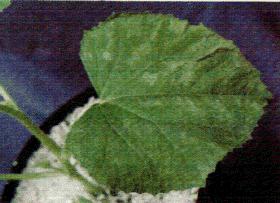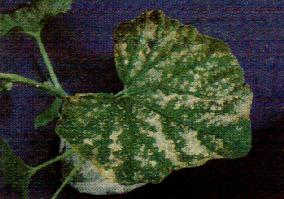
The muskmelon plant problem on acid soils develops as a breakdown and eventual death of the older leaves, usually at the time the plant is carrying a load of fruit (Fig 1). However, in severe cases, a general lack of vigorous plant growth is obvious from time of transplanting. The injury can show up on seemingly healthy, vigorous plants in late June or early July following a heavy rain.
The Mn toxicity symptoms develop as pale green or yellow spotting on the upperside of older leaves (Fig. 2), with water-soaked rings around necrotic spots on the underside (Figs. 3,4). The necrotic spots expand rapidly and coalesce into dead tissue areas (Fig. 5); the result is complete death of older leaves in a week's time.
Magnesium deficiency develops first on the older leaves as an interveinal bronzing, progressing to total necrosis and browning of the interveinal tissue (Fig. 8). On the older plants the older leaf tissue has green veins with white interveinal tissue that deteriorates to a skeletonized leaf condition (Figs. 9,10).
To determine the specific problem, collect leaf samples of the affected plants along with soil samples from their rooting area. Analyze the leaf tissue specifically for Mg and Mn, and the soil specifically for pH and Mg. Determine soil pH in a water slurry (pH water); also, to simulate effects of fertilizer salts, add 5 ml 1N KCL to the water slurry for a second pH measurement (pH salt). Diagnosis is made on the basis of analytical values found in the tissue and soil.
The problem is one that is best corrected for the following crop, due to the requirement for thorough mixing of lime with soil. The Mn toxicity is corrected by adjusting soil to pH 6.0 or above with lime application. The soil analysis provides a lime requirement value that indicates the amount of lime required to raise soil to pH 6.0-6.5. Apply lime only on the basis of soil test and lime requirement value. Magnesium deficiency is corrected with the addition of Mg to increase exchangeable Mg to 75 pounds Mg per acre. Magnesium deficiency can be corrected in low pH soils by using dolomitic limestone. In low magnesium, high pH soils, apply 50-100 pounds Mg per acre as a soluble Mg salt.
Mg Mn
---------------- ----------------------
Toxicity
Deficient Adequate Adequate Excess symptoms
-------------------------------------------------
ppm
Tissue /6.0 >5.5
Mn toxicity < 5.5 < 5.0
Soil Analysis Values for Diagnosis of Mg Status
Mg status Exchangeable Mg
-----------------------------------------
lb./a.
Adequate > 75
Response range 35-70
Deficiency symptoms < 35
-----------------------------------------

Manganese Toxicity

Water soaked spots with necrotic center on underside of leaf:



Manganese toxicity developed in the greenhouse


Manganese Deficiency

Right to left--Normal, interveinal tissue bronzing, Necrosis, Browning


Greenhouse progression of Mg deficiency development



RR 10/88
Cooperative Extension work in Agriculture and Home Economics, State of Indiana, Purdue University and U.S. Department of Agriculture cooperating: H.A. Wadsworth, Director, West Lafayette, IN. Issued in furtherance of the acts of May 8 and June 30, 1914. The Cooperative Extension Service of Purdue University is an equal opportunity/equal access institution.